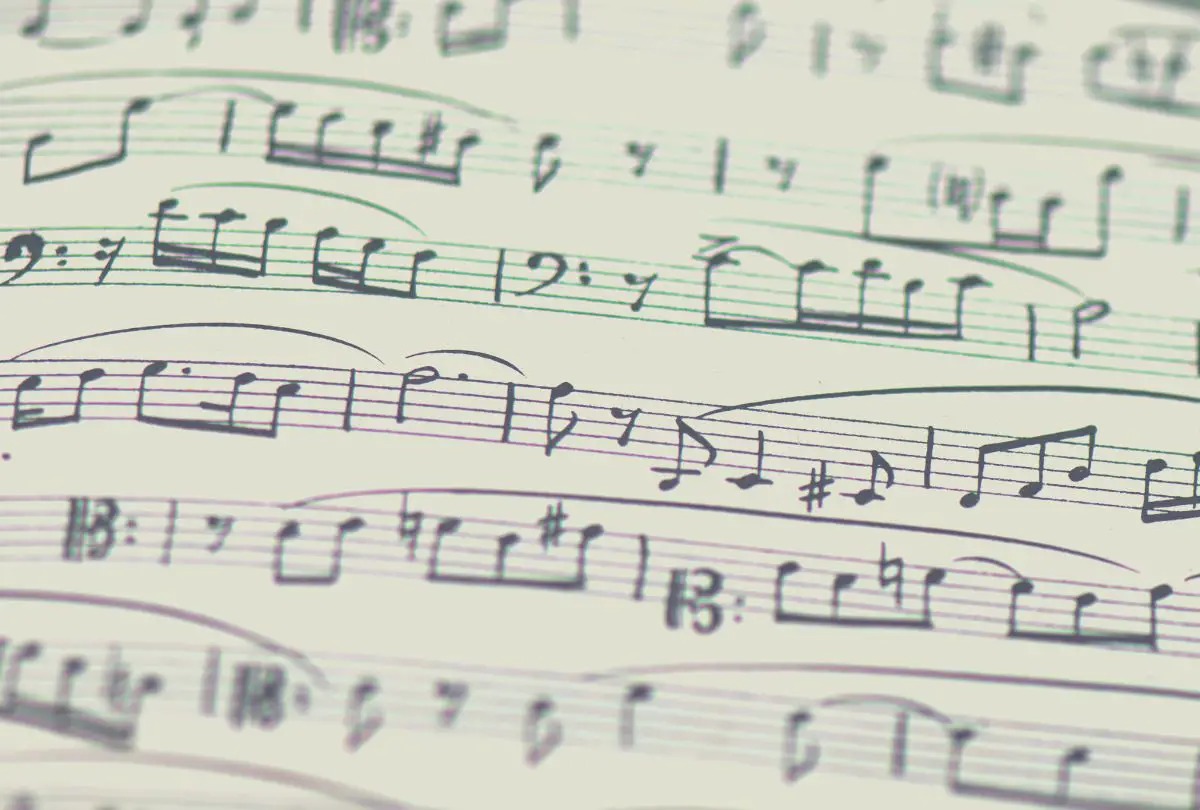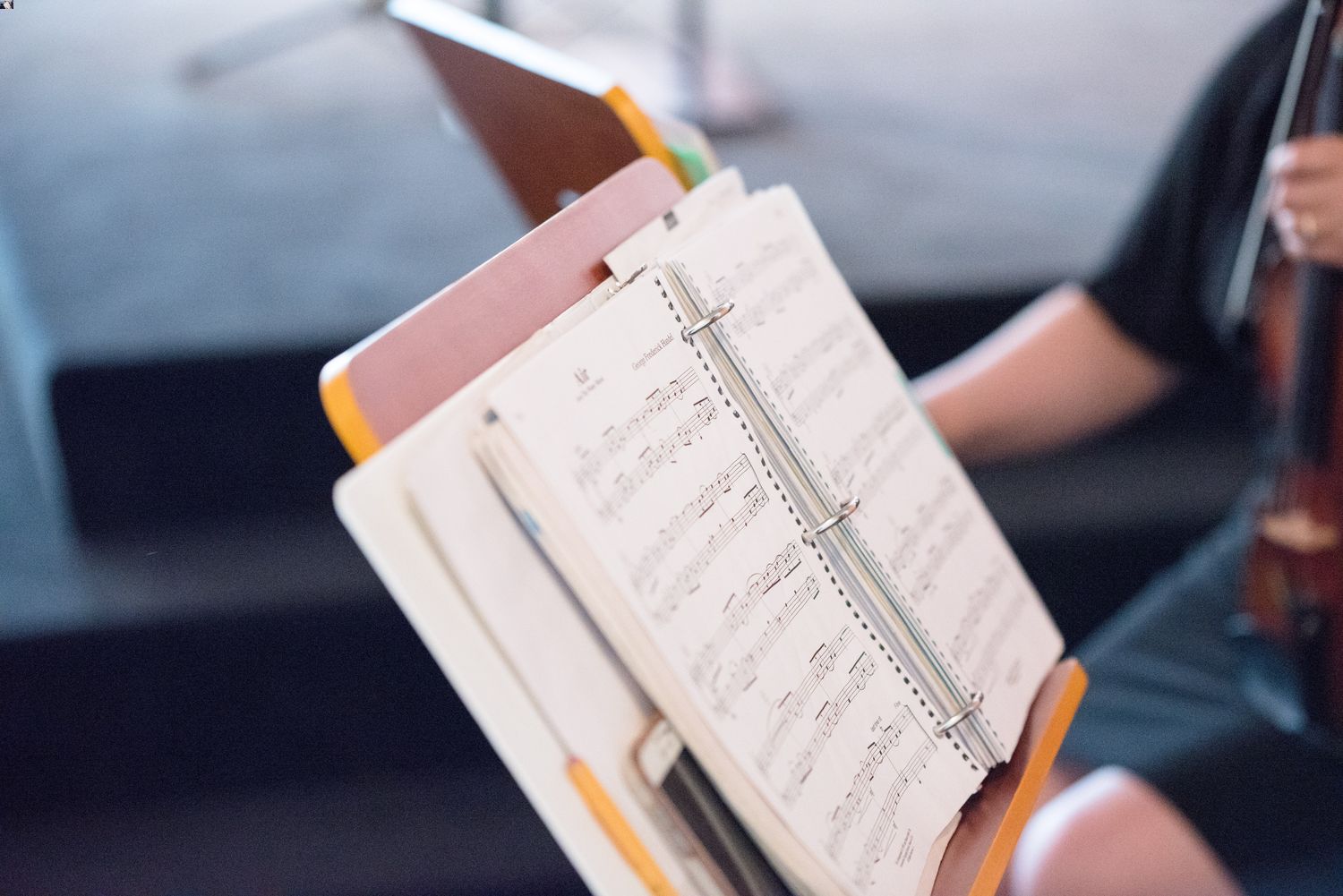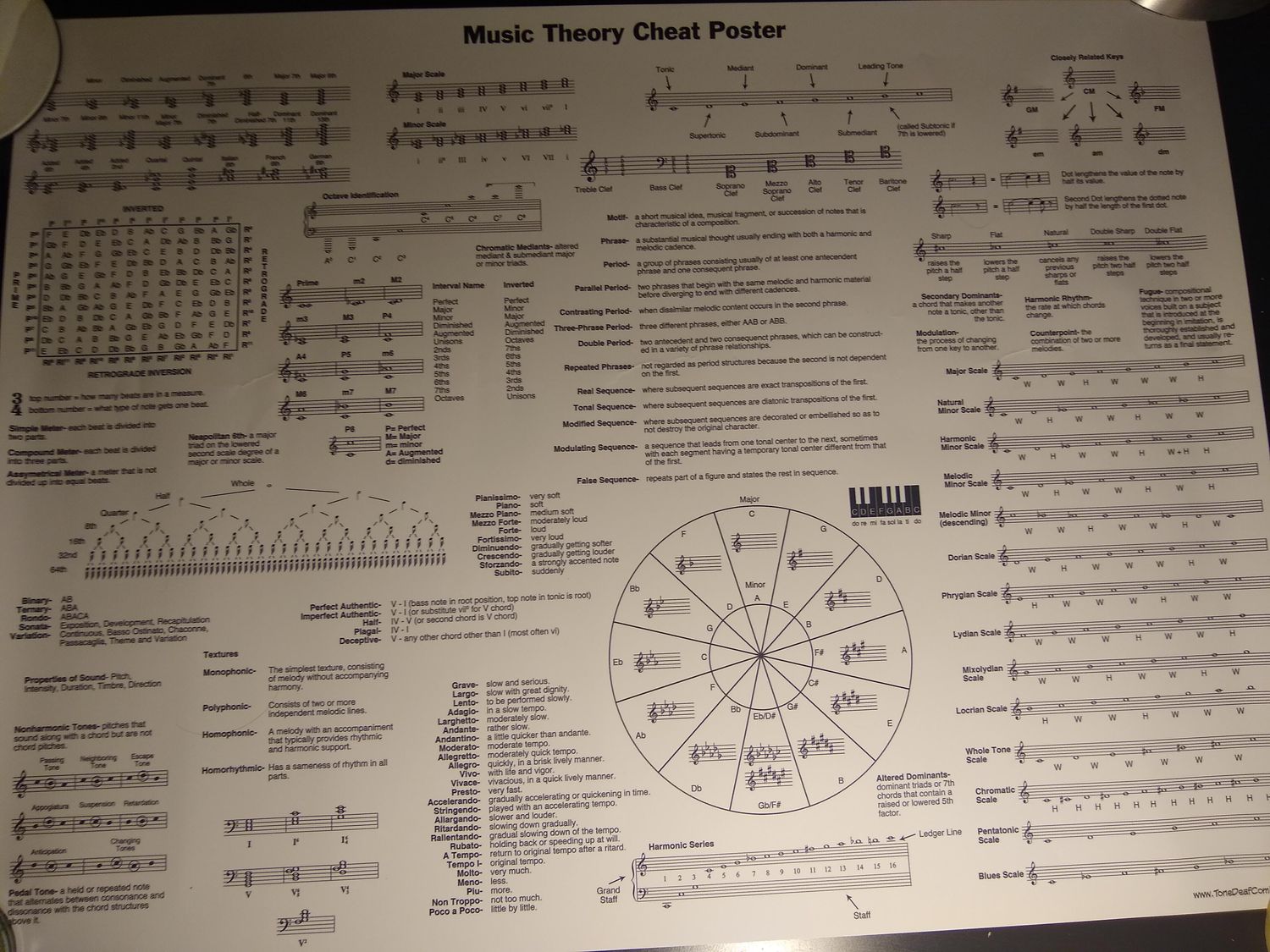Home>Production & Technology>Music Theory>How Long It Take To Learn Music Theory


Music Theory
How Long It Take To Learn Music Theory
Modified: January 30, 2024
Discover how long it takes to master music theory and become a skilled musician. Find out the best methods and resources for learning music theory.
(Many of the links in this article redirect to a specific reviewed product. Your purchase of these products through affiliate links helps to generate commission for AudioLover.com, at no extra cost. Learn more)
Table of Contents
Introduction
Welcome to the fascinating world of music theory! Whether you are a budding musician, a curious music enthusiast, or someone looking to deepen their understanding of music, learning music theory is an essential step on your musical journey. Music theory provides the foundation for understanding how music works, enabling you to analyze, compose, and appreciate music in a more profound way.
Music theory encompasses a wide range of concepts and principles, from note reading and rhythm to more advanced topics like harmonic progressions and musical analysis. Understanding these elements allows you to decipher musical notation, identify the structure and key of a piece, and even compose your own music.
While many musicians learn to play an instrument without formal music theory training, delving into music theory can greatly enhance your musical abilities. It provides you with a deeper understanding of the music you play, allowing you to interpret and perform it with greater expression and nuance.
Now, you might be wondering, how long does it take to learn music theory? The answer to that question can vary depending on various factors, including your musical background, dedication, and the level of proficiency you aim to achieve. Let’s explore the basics of music theory and the different elements involved, so you can gain a better understanding of the learning process.
The Basics of Music Theory
Before diving into the fascinating world of music theory, it’s important to understand the foundational concepts that underpin this discipline. Here are the key elements you’ll encounter in your music theory journey:
- Notes: In music, notes are the building blocks of melody and harmony. A note represents a specific pitch and duration. Understanding the different note names, durations, and their placement on the staff is crucial for reading and interpreting musical notation.
- Rhythm: Rhythm refers to the timing and duration of musical sounds. Learning about different rhythmic values, such as whole notes, half notes, quarter notes, and their corresponding rests, allows you to accurately read and perform rhythms written in sheet music.
- Key Signatures: Key signatures are a set of sharps or flats placed at the beginning of a musical staff, indicating the tonality or key of a piece of music. Familiarizing yourself with key signatures helps you identify the notes and chords that are most commonly used in a particular key.
- Scales: Scales are sequences of notes played in ascending or descending order. Major and minor scales are the most common scales used in Western music. Understanding the patterns and intervals within scales helps you grasp melodies and harmonies more easily.
- Chords: Chords are formed by playing multiple notes simultaneously. They provide the harmonic foundation in music. Learning about basic chord types, such as major and minor chords, and how they are constructed empowers you to analyze and play chord progressions.
These are just a few of the fundamental concepts in music theory. As you progress, you’ll encounter more complex topics like musical form, analysis, and even advanced harmony. The key to mastering music theory is to start with a solid understanding of these basics and gradually build upon them.
Remember, learning music theory is not just about memorizing facts and figures; it’s about understanding the principles that govern the art of music. It requires active engagement, practice, and a willingness to explore and experiment. So, grab your instrument, open your mind, and embark on an exciting journey through the world of music theory!
Note Reading and Rhythm
One of the fundamental skills in music theory is note reading and rhythm. This involves understanding how musical notes are represented on the staff and how they are played in terms of duration. Let’s take a closer look at these concepts:
Note Reading: Musical notes are represented on the staff, which consists of horizontal lines and spaces. Each line and space corresponds to a specific pitch. Learning to read notes on the staff allows you to decipher musical melodies and play them on your instrument. Familiarizing yourself with note names, such as A, B, C, D, E, F, and G, and their corresponding positions on the staff is essential for fluent note reading.
Rhythm: Rhythm is the backbone of music. It refers to the timing and duration of musical sounds and rests. Musical rhythms are represented by different note values, such as whole notes, half notes, quarter notes, eighth notes, and sixteenth notes. Rests, on the other hand, represent silent beats or pauses in the music. Understanding rhythmic values and their corresponding rests enables you to accurately read and interpret rhythm notation.
As you delve deeper into note reading and rhythm, you’ll also encounter other important concepts, such as time signatures and tempo. Time signatures indicate the organization of beats in a musical piece, while tempo refers to the speed at which the music is played. Understanding these concepts allows you to play music with the correct timing and feel.
Developing proficiency in note reading and rhythm takes time and practice. Start by familiarizing yourself with the basic note names and their positions on the staff. Practice reading simple melodies and rhythms, gradually progressing to more complex pieces as your skills improve. It’s also beneficial to practice clapping or tapping rhythms to develop a strong sense of timing and internalize different rhythmic patterns.
Remember, note reading and rhythm are essential skills for musicians of all levels. Whether you’re playing solo, in an ensemble, or even composing your own music, having a solid foundation in note reading and rhythm allows you to accurately interpret and perform music with confidence and precision.
Key Signatures and Scales
Key signatures and scales are fundamental concepts in music theory that provide the basis for understanding tonality and constructing melodies and harmonies. Let’s explore these concepts in more detail:
Key Signatures: Key signatures are symbols placed at the beginning of a piece of music to indicate the key or tonality. They consist of sharps (#) or flats (b) placed on certain lines or spaces of the staff. Key signatures are used to determine the set of notes and chords that are most commonly used in a particular key. By understanding key signatures, you can identify and play the correct notes and chords while reading sheet music.
For example, if a piece of music has one sharp in its key signature, it is in the key of G major or E minor. The sharp symbol placed on the F line of the staff indicates that every F in the music should be played as an F#. Similarly, a piece with two flats in its key signature is in the key of B-flat major or G minor. The flat symbols on the B and E lines of the staff indicate that every B and E should be played as a B-flat and E-flat, respectively.
Scales: Scales are sequences of notes played in ascending or descending order. They serve as the foundation for melodies and harmonies in music. The most common scales used in Western music are major and minor scales.
A major scale is constructed using a specific pattern of whole steps (W) and half steps (H) between the notes. The most well-known major scale is the C major scale, which consists of the notes C, D, E, F, G, A, and B. By understanding the pattern of whole and half steps, you can play major scales in any key.
Minor scales have a slightly different pattern of whole and half steps, resulting in a different sound and mood. The most common type of minor scale is the natural minor scale, which is used in many musical genres. For example, the A natural minor scale consists of the notes A, B, C, D, E, F, and G.
By practicing major and minor scales in different keys, you develop a strong foundation for playing melodies and harmonies. Scales also provide a framework for improvisation and composition, as they help you understand the relationships between different notes within a key.
As you delve further into music theory, you’ll encounter other types of scales, such as the pentatonic scale, blues scale, and modes. These scales add color and flavor to your playing, allowing for more expressive and creative musical expression.
Understanding key signatures and scales is essential for musicians in all genres. It enables you to navigate the tonal landscape of music, identify common chord progressions, and ultimately, create and perform melodies and harmonies with confidence and musicality.
Chords and Harmonic Progressions
Chords and harmonic progressions are foundational elements of music theory that play a crucial role in creating harmonies and conveying emotion in music. Let’s explore these concepts in more detail:
Chords: A chord is a group of three or more notes played simultaneously. Chords provide the harmonic foundation of a piece of music and contribute to its overall sound and mood. Understanding different chord types and their construction is essential for analyzing and playing music.
Common chord types include major chords, minor chords, diminished chords, and augmented chords. Major chords have a bright, happy sound, while minor chords evoke a sense of melancholy or sadness. Diminished chords create tension, and augmented chords provide a sense of instability or anticipation.
Chords are typically indicated by symbols such as C, Dm, G7, or Amaj7. These symbols represent the root note of the chord and provide information about its quality and any additional notes or alterations.
Harmonic Progressions: Harmonic progressions refer to the sequence of chords used in a piece of music. They establish the tonal center and create tension and resolution. Common harmonic progressions, such as the I-IV-V progression, are used in various genres and evoke a sense of familiarity and stability.
An example of the I-IV-V progression in the key of C major would involve the chords C, F, and G. By learning and analyzing different harmonic progressions, you can identify recurring patterns and chord relationships in music.
Understanding chords and harmonic progressions allows you to accompany melodies, create chord progressions, and even compose your own music. By experimenting with different chord voicings and progressions, you can add your own unique touch and expressiveness to your musical performances.
As you progress in your music theory journey, you’ll encounter more complex chords, such as extended and altered chords, as well as more intricate harmonic progressions. These concepts expand your harmonic vocabulary and provide opportunities for more advanced harmonic exploration and composition.
Developing your ear training skills can greatly enhance your understanding and utilization of chords and harmonic progressions. By training your ear to recognize different chord qualities and progressions, you can develop a deeper musical intuition and make more informed musical choices.
In summary, chords and harmonic progressions are essential elements of music theory. By studying and practicing these concepts, you gain the ability to create and interpret harmonies, further enhancing your musical abilities and allowing you to connect with listeners on a deeper level.
Musical Form and Analysis
Musical form and analysis are vital aspects of music theory that delve into the organization and structure of a piece of music. By studying musical form and analyzing compositions, you gain insights into the composer’s intentions and can develop a deeper appreciation for their artistic choices. Let’s explore these concepts further:
Musical Form: Musical form refers to the overall structure and organization of a piece of music. It encompasses the arrangement and relationship of different sections within a composition, such as verses, choruses, bridges, and codas. Understanding musical form allows you to identify recurring themes, contrasting sections, and the logic behind the progression of the music.
Common musical forms include the binary form (AB), ternary form (ABA), and rondo form (ABACADA). Each form has its own unique characteristics and provides a framework for composers to develop and shape their musical ideas.
Analysis: Musical analysis involves studying and breaking down a piece of music to understand its structure, harmonic progressions, melodic motifs, and other compositional elements. Analysis allows you to uncover the underlying musical principles and gain a deeper understanding of a composition’s inner workings.
When analyzing a piece of music, you may explore elements such as the key signature, chord progressions, melodic contour, rhythmic patterns, and dynamic changes. This process helps you identify patterns, relationships, and thematic development, providing insights into the composer’s choices and intentions.
By studying musical form and analysis, you can develop a more refined appreciation of music and enhance your own musical abilities. Analyzing compositions from different time periods and genres exposes you to a diverse range of musical styles and techniques.
Music theory and analysis go hand in hand, providing you with tools to unravel the complexities of music and gain a deeper understanding of its inner workings. Whether you’re a performer, composer, or music enthusiast, studying musical form and analysis allows you to approach music with a critical ear and a deeper appreciation for its artistic intricacies.
Remember, the study of musical form and analysis is a continual process. As you encounter more pieces and delve into different genres and styles, you’ll develop a more nuanced understanding of musical structures and the techniques employed by composers throughout history.
Ear Training and Sight Singing
Ear training and sight singing are essential components of music theory that develop your ability to perceive and reproduce musical sounds accurately. By honing these skills, you enhance your overall musicianship and become a more sensitive and proficient musician. Let’s explore the importance of ear training and sight singing:
Ear Training: Ear training focuses on developing your ability to recognize and reproduce musical elements, such as intervals, chords, melodies, and rhythms, purely by hearing them. It helps you develop a keen sense of pitch, tonality, and musical nuance.
Ear training exercises include identifying intervals (the distance between two notes), recognizing chord progressions, and transcribing melodies by ear. These exercises train your ear to discern musical patterns and improve your ability to play by ear, improvise, and compose.
Developing strong ear training skills allows you to play music with greater accuracy, perform in ensembles with better intonation and blend, and improvise with confidence. It helps you connect more deeply with the music and facilitates effective communication with other musicians.
Sight Singing: Sight singing involves the ability to read and sing musical notation in real-time. It requires you to quickly translate the written music into vocal sound without the aid of an instrument.
In sight singing, you must accurately interpret the note pitches, rhythms, and dynamics while maintaining proper vocal technique. It requires the integration of musical knowledge, note reading skills, and aural comprehension.
Sight singing exercises often involve singing through musical exercises, melodies, or vocal exercises while following the written music. These exercises help you develop fluency in reading and interpreting musical notation, improve your pitch accuracy, and strengthen your vocal agility.
Both ear training and sight singing are complementary skills that reinforce each other. By improving your ear training, you become better at recognizing and reproducing musical sequences, which in turn enhances your sight singing abilities. Likewise, sight singing proficiency supports your ear training by reinforcing your ability to accurately interpret written musical symbols.
Practicing ear training and sight singing regularly is crucial to strengthening these skills. Engaging in exercises that focus on intervals, chord recognition, rhythm, and sight singing melodies helps you develop a well-rounded musical ear and the ability to perform with accuracy and confidence.
Remember, ear training and sight singing are skills that can be developed with consistent practice and dedication. By sharpening your musical perception and improving your ability to reproduce music accurately, you become a more versatile and expressive musician.
Advanced Music Theory Concepts
Once you have built a solid foundation in music theory, you can delve into more advanced concepts that will further expand your understanding and appreciation of music. These advanced music theory concepts allow you to analyze and interpret music at a deeper level and provide you with a broader range of tools for composition and creative expression. Let’s explore some of these concepts:
Modal Harmony: Modal harmony explores scales and tonalities beyond the traditional major and minor scales. Modes, such as the Dorian, Phrygian, and Mixolydian modes, provide different tonal colors and moods. Understanding modal harmony allows you to experiment with unique soundscapes and create compositions with distinct flavors and textures.
Extended Chords: Extended chords expand beyond basic triads to include additional chord tones, such as seventh, ninth, eleventh, and thirteenth chords. These chords add richness and complexity to harmonies, giving you more options for creating lush, sophisticated sounds in your compositions.
Counterpoint: Counterpoint is the art of combining multiple melodic lines that are independent yet harmonically pleasing when played together. Studying counterpoint helps you develop the skills to create intricate and balanced melodies that intertwine and interact harmoniously.
Chromaticism: Chromaticism involves the use of notes outside of the key to create tension and color in a composition. By incorporating chromatic elements, such as chromatic scales, chromatic chords, and chromatic passing tones, you can add complexity and unexpected twists to your musical compositions.
Mode Mixture: Mode mixture, also known as modal interchange, refers to the borrowing of chords and melodic elements from parallel major or minor keys. This technique adds a sense of freshness and contrast to harmonies, allowing you to blend different tonalities and create unexpected harmonic progressions.
Polyrhythms and Polymeters: Polyrhythms involve the simultaneous use of multiple rhythmic patterns, while polymeters combine different time signatures within a composition. These techniques create rhythmic complexity and tension, adding rhythmic interest and intrigue to your musical compositions.
Microtonality: Microtonality explores the use of intervals smaller than a semitone, allowing for a wider range of pitch possibilities. It challenges traditional Western musical conventions and opens up new avenues for exploring different tuning systems and expressive possibilities in your compositions.
Exploring these advanced music theory concepts allows you to push the boundaries of traditional tonality and experiment with new ways of creating and perceiving music. Whether you are composing, arranging, or analyzing music, these concepts provide you with a deeper understanding and expanded palette of musical elements to work with.
Keep in mind that mastering advanced music theory concepts requires dedicated study, practice, and continued exploration. As you delve into these concepts, you’ll discover a world of possibilities that will enhance your creativity and broaden your musical horizons.
Putting it all Together: Practical Applications
Now that you have a solid understanding of various music theory concepts, it’s time to explore the practical applications of this knowledge in your musical journey. Here are some ways you can put it all together:
Composition and Songwriting: Music theory provides a framework for composing your own music and writing songs. Armed with a deeper understanding of scales, chords, and harmonic progressions, you can create melodies and harmonies that evoke specific emotions and convey your artistic vision. Experiment with different chord progressions, explore unconventional melodic ideas, and use your knowledge of music theory to craft compelling compositions.
Arranging and Orchestration: If you’re interested in arranging music for different instruments or ensembles, music theory is your guiding light. Understanding how melodies and harmonies interact allows you to create lush and engaging arrangements. You can also explore different textures, dynamics, and instrument combinations to bring out the full potential of your arrangements.
Improvisation: Music theory provides a solid foundation for improvisation. Understanding scales, chord progressions, and how they relate to different musical styles enables you to confidently improvise melodies and solos. By internalizing the language of music theory, you can freely express yourself and create spontaneous musical ideas in the moment.
Analysis and Interpretation: Music theory allows you to analyze and interpret existing musical compositions with a deeper understanding. By analyzing the structure, harmony, and melodic elements of a piece, you gain insights into the composer’s intentions and can make informed interpretative choices when performing. This knowledge also enhances your ability to appreciate and connect with the music on a deeper level.
Teaching and Education: If you have a passion for sharing your musical knowledge, understanding music theory equips you to teach others. Whether you’re instructing beginners or advanced musicians, you can guide them in understanding the building blocks of music, enhancing their skills, and nurturing their creativity.
These practical applications of music theory empower you to express yourself more confidently as a musician. Remember, while understanding music theory is essential, it should always serve as a tool to enhance your musicality and expressiveness rather than limit your creativity. Be open to experimentation, incorporate your personal musical tastes, and continue exploring and expanding your musical horizons.
As you integrate music theory into your musical practice, you’ll discover endless opportunities to apply and expand upon your knowledge. Embrace the joy of creating, sharing, and exploring music, and let music theory be your guide on this exciting journey.
Conclusion
Congratulations on embarking on your music theory journey! You have now gained a solid understanding of the fundamental concepts and practical applications of music theory. By delving into note reading, rhythm, key signatures, scales, chords, harmonic progressions, musical form, analysis, ear training, sight singing, and advanced music theory concepts, you have acquired a comprehensive toolkit to enhance your musicality and expression.
Music theory serves as a bridge between the technical aspects of music and the emotional impact it can have on both the performer and the listener. It provides the language and structure to understand, analyze, and create music in a meaningful and intentional way.
Remember that music theory is a lifelong journey. As you continue to explore and deepen your knowledge, you will uncover new layers of understanding and refine your musical skills. The practical applications of music theory, whether in composing, arranging, improvising, performing, or teaching, will empower you to express yourself, connect with others, and create memorable musical experiences.
As you continue on your musical path, stay curious, experiment, and listen to a wide variety of music. Be open to new ideas and embrace the joy of discovery. Music theory is not meant to constrain your creativity but rather to enhance and guide it.
So, keep learning, practicing, and immersing yourself in music. Embrace the beauty and intricacies of music theory, and let it become an integral part of your musical journey. Let music theory be your foundation and your inspiration as you create, interpret, and share the gift of music with the world.











